Module 9 Unit 3 Language in use课件(共30张PPT)
文档属性
| 名称 | Module 9 Unit 3 Language in use课件(共30张PPT) | 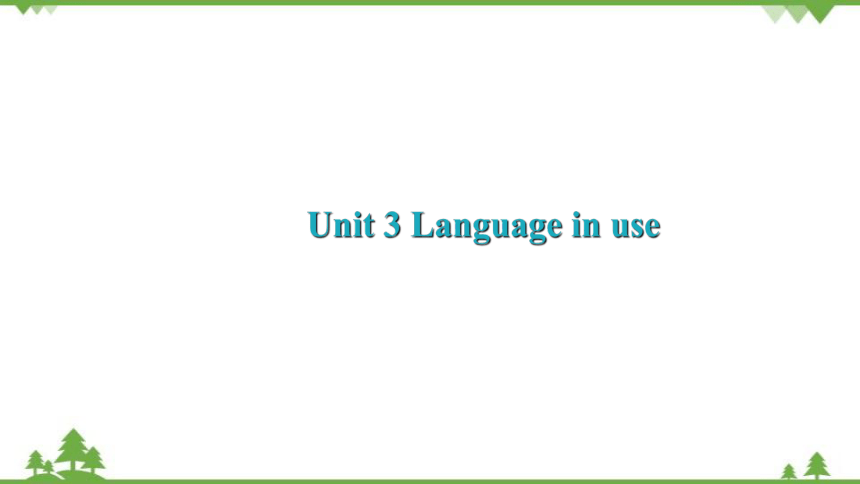 | |
| 格式 | ppt | ||
| 文件大小 | 156.0KB | ||
| 资源类型 | 教案 | ||
| 版本资源 | 外研版 | ||
| 科目 | 英语 | ||
| 更新时间 | 2022-08-14 11:21:59 | ||
图片预览

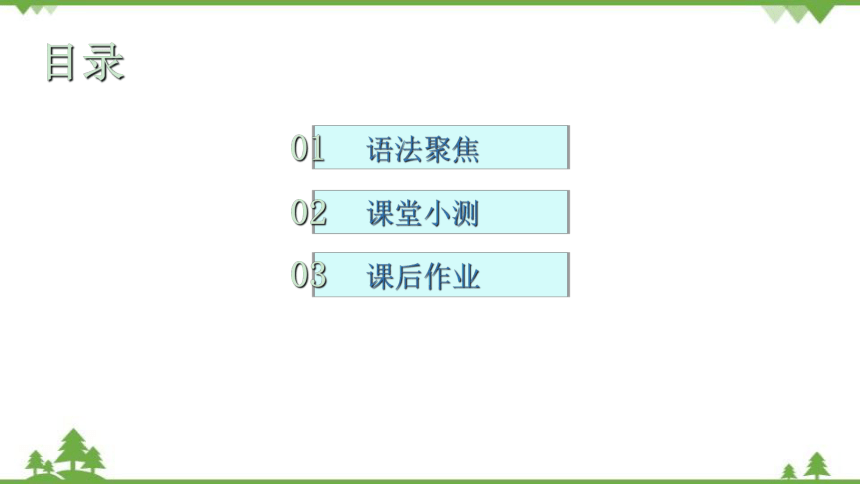
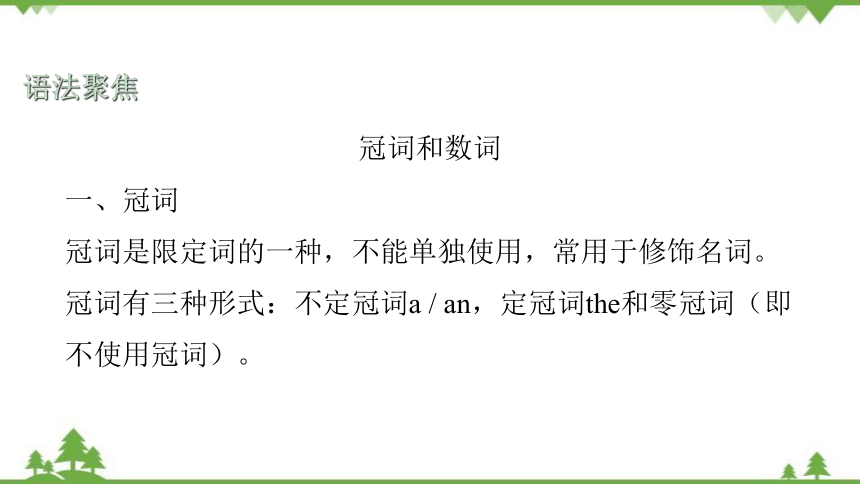

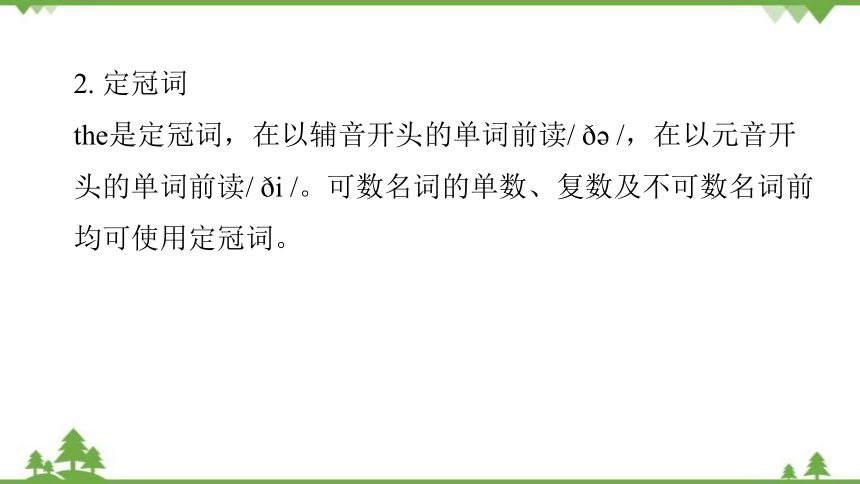
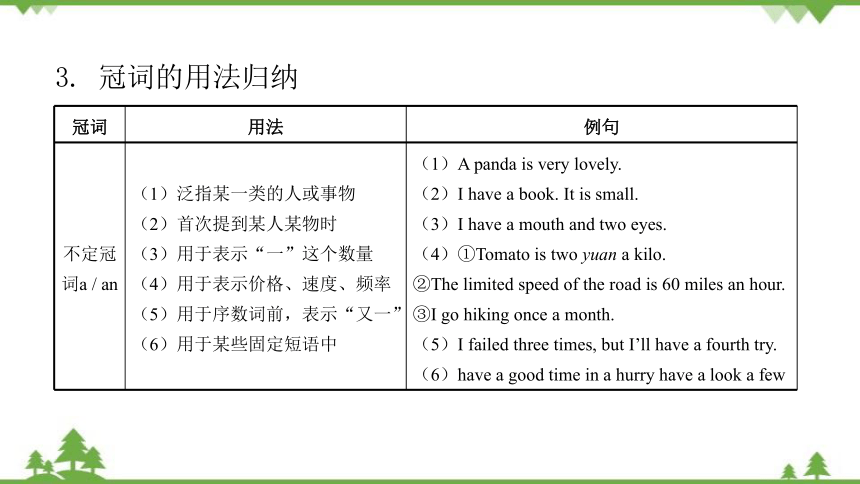
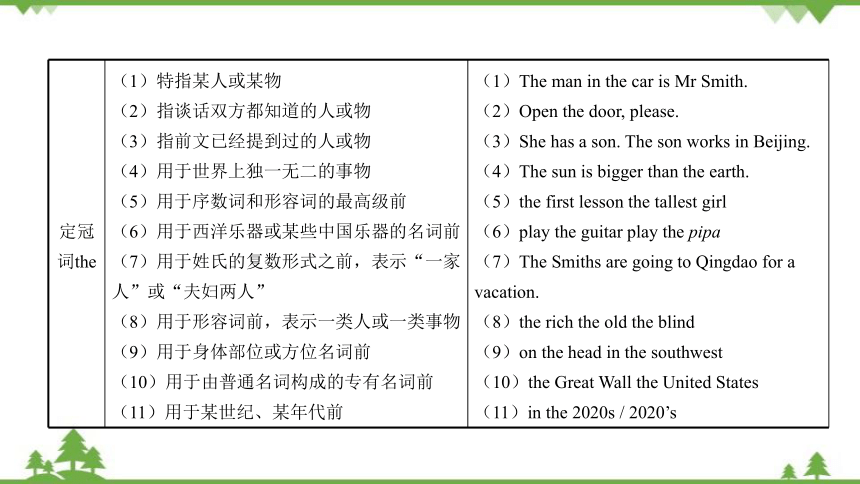

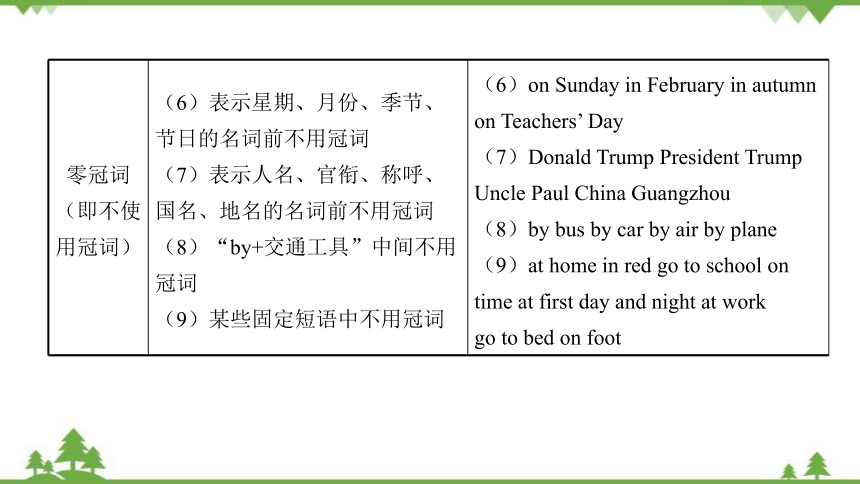
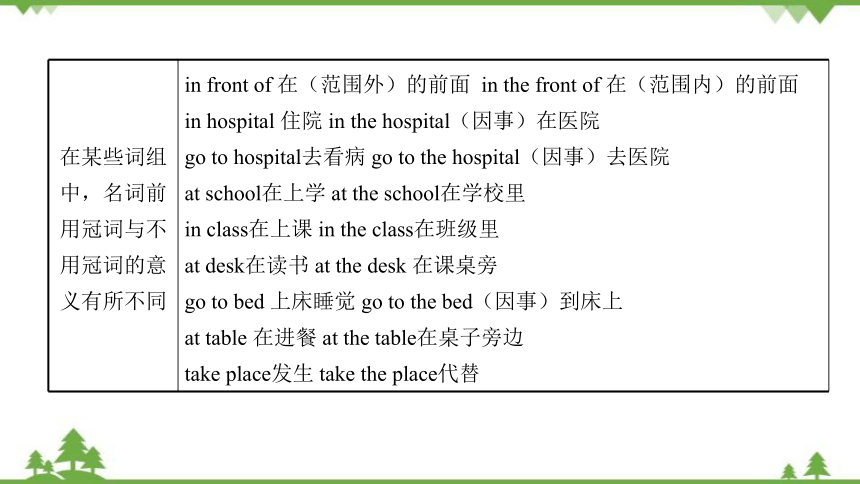
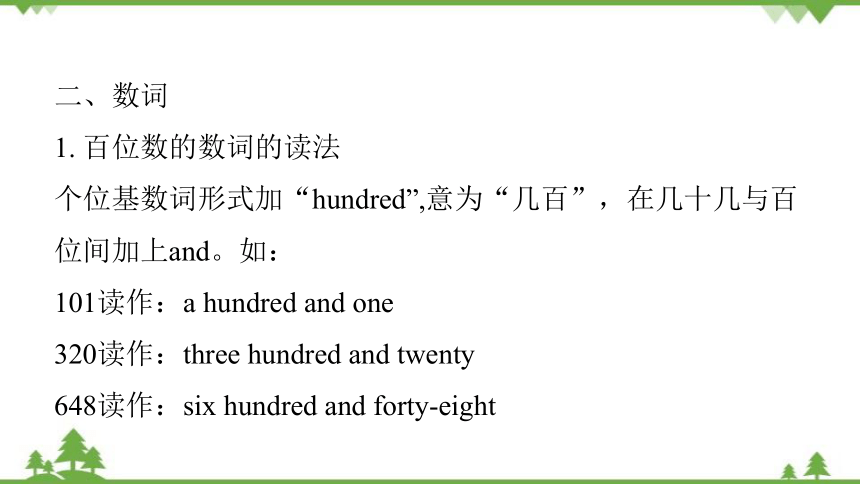
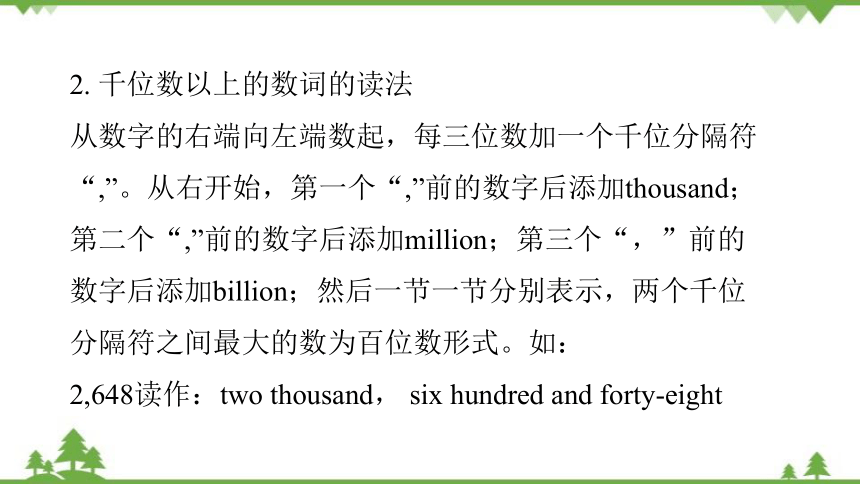
文档简介
(共30张PPT)
Unit 3 Language in use
目录
语法聚焦
01
课堂小测
02
课后作业
03
语法聚焦
冠词和数词
一、冠词
冠词是限定词的一种,不能单独使用,常用于修饰名词。冠词有三种形式:不定冠词a / an,定冠词the和零冠词(即不使用冠词)。
1. 不定冠词
不定冠词用来修饰可数名词单数,指人或物中的某一个或某一类,但不具体说明是何人何物。在名词前使用a还是an取决于该名词的读音。如果首字母的读音是元音音素,应用an;如果首字母的读音是辅音音素,应用a。
2. 定冠词
the是定冠词,在以辅音开头的单词前读/ /,在以元音开头的单词前读/ i /。可数名词的单数、复数及不可数名词前均可使用定冠词。
冠词 用法 例句
不定冠
词a / an (1)泛指某一类的人或事物
(2)首次提到某人某物时
(3)用于表示“一”这个数量
(4)用于表示价格、速度、频率
(5)用于序数词前,表示“又一”
(6)用于某些固定短语中 (1)A panda is very lovely.
(2)I have a book. It is small.
(3)I have a mouth and two eyes.
(4)①Tomato is two yuan a kilo.
②The limited speed of the road is 60 miles an hour.
③I go hiking once a month.
(5)I failed three times, but I’ll have a fourth try.
(6)have a good time in a hurry have a look a few
3. 冠词的用法归纳
定冠词the (1)特指某人或某物
(2)指谈话双方都知道的人或物
(3)指前文已经提到过的人或物
(4)用于世界上独一无二的事物
(5)用于序数词和形容词的最高级前
(6)用于西洋乐器或某些中国乐器的名词前
(7)用于姓氏的复数形式之前,表示“一家人”或“夫妇两人”
(8)用于形容词前,表示一类人或一类事物
(9)用于身体部位或方位名词前
(10)用于由普通名词构成的专有名词前
(11)用于某世纪、某年代前 (1)The man in the car is Mr Smith.
(2)Open the door, please.
(3)She has a son. The son works in Beijing.
(4)The sun is bigger than the earth.
(5)the first lesson the tallest girl
(6)play the guitar play the pipa
(7)The Smiths are going to Qingdao for a vacation.
(8)the rich the old the blind
(9)on the head in the southwest
(10)the Great Wall the United States
(11)in the 2020s / 2020’s
零冠词
(即不使
用冠词) (1)指示代词前不用冠词
(2)形容词性物主代词前不用冠词
(3)名词所有格前不用冠词
(4)在some, any, no, every等限定词前不用冠词
(5)表示语言、科目、三餐、球类、棋类的名词前不用冠词 (1)this car
(2)his desk
(3)Chairman Xi’s speech
(4)some people any other country
no photo every person
(5)in English learn geography
have breakfast play football play chess
零冠词
(即不使
用冠词) (6)表示星期、月份、季节、节日的名词前不用冠词
(7)表示人名、官衔、称呼、国名、地名的名词前不用冠词
(8)“by+交通工具”中间不用冠词
(9)某些固定短语中不用冠词 (6)on Sunday in February in autumn
on Teachers’ Day
(7)Donald Trump President Trump Uncle Paul China Guangzhou
(8)by bus by car by air by plane
(9)at home in red go to school on time at first day and night at work
go to bed on foot
在某些词组中,名词前用冠词与不用冠词的意义有所不同 in front of 在(范围外)的前面 in the front of 在(范围内)的前面
in hospital 住院 in the hospital(因事)在医院
go to hospital去看病 go to the hospital(因事)去医院
at school在上学 at the school在学校里
in class在上课 in the class在班级里
at desk在读书 at the desk 在课桌旁
go to bed 上床睡觉 go to the bed(因事)到床上
at table 在进餐 at the table在桌子旁边
take place发生 take the place代替
二、数词
1. 百位数的数词的读法
个位基数词形式加“hundred”,意为“几百”,在几十几与百位间加上and。如:
101读作:a hundred and one
320读作:three hundred and twenty
648读作:six hundred and forty-eight
2. 千位数以上的数词的读法
从数字的右端向左端数起,每三位数加一个千位分隔符“,”。从右开始,第一个“,”前的数字后添加thousand;第二个“,”前的数字后添加million;第三个“,”前的数字后添加billion;然后一节一节分别表示,两个千位分隔符之间最大的数为百位数形式。如:
2,648读作:two thousand, six hundred and forty-eight
16,250,064读作:sixteen million, two hundred and fifty thousand, sixty-four
5,237,166,234读作:five billion, two hundred and thirty-seven million, one hundred and sixty-six thousand, two hundred and thirty-four
3. 分数的表示法
(1)分数是由基数词和序数词一起来表示的。基数词作分子,序数词作分母,除了分子是“1”以外,其他情况下分母都要用复数形式。如:
one half one third two thirds three fourths
(2)当分数后面接名词时,如果分数表示的值大于1,名词用复数形式;如小于1,名词用单数形式。如:metre 二分之一米 metres 一又二分之一米
课堂小测
eport
ncrease
一、根据中文意思或首字母提示,用单词的适当形式填空
1.Wide reading will i________ your vocabulary.
2.We should make a r________ to the head teacher before we do it.
cause
uiet
government
3.You must give up smoking. It can_________________ (引起)some serious illnesses.
4.How q________ this evening is! I think you must sleep well.
5.Thanks to the growing population,the_________________ (政府)needs to build more homes.
the
/
二、用a,an,the或/填空
6.—Do you know _________________ girl over there
—Yes, she likes playing _________________ basketball a lot.
7.It’s time for_________________ breakfast.
/
the
a
an
8.Chinese people usually eat zongzi on _________________ Dragon Boat Festival.
9.We all know _________________ earth goes round _________________ sun.
10. I think English is _________________ useful language, and it’s also _________________ important language.
the
the
C
三、单项填空
( )11. If you want to take_________________ short ride in the city, choose _________________ shared bike.
A. a;/ B. the; the
C. a; a D. /; a
C
( )12. Qingdao is a beautiful city that lies in_________________ east of China.
A. an B. /
C. the D. a
A
( )13. Because of the special situation this year, about_________________ of the students in our school _________________ having classes on the Internet at home.
A. two thirds; are B. two third; is
C. second thirds; are D. two thirds; is
C
( )14. —Will you come to my_________________ birthday party next Friday, Susan
—Yes, of course. And I’ll bring a nice gift for you.
A. eighteen B. eighteens
C. eighteenth D. the eighteenth
( )15. Nowadays,_________________ people like HUAWEI phones better, and about _________________ of them are adults.
A.the number of; four fifths
B.a number of; four fifth
C.a number of; four fifths
D.the number of; four five
C
四、语法选择
Do you know 16 people there were in the world 200 years ago Just one billion. 17 only 100 years later, the population was increased by 100 percent. In 1971, about 3.5 18 people lived on the earth. Forty years later, the number doubled(翻倍). 19 31st October, 2001, the 7 billionth world citizen(公民), 20 baby girl was born in the Philippines(菲律宾). At this speed, it will shoot up to 8 billion by the year 2025.
Most new babies were born in developing countries. Most families have four or five children. In many 21 countries, the population is increasing 22 . Most families have only one or two babies. In 1950, about 25 percent of the world’s population lived in developed countries. By 2050, the number will reduce to 10 percent.
In many developing countries, people are now short of food, water and medicine. What’s worse, farmland 23 less and less. Farmers are moving to cities to make a living. But cities can’t satisfy(满足) 24 needs at all. Finally, many people can’t find jobs, and they become poorer and poorer.
25 these problems, many developing countries are taking measures to control the population.
( )16. A. how often B. how much
C. how many D. how far
( )17. A. But B. And C. Because D. So
( )18. A. billions of B. billion of
C. billion D. billions
( )19. A. In B. At C. For D. On
( )20. A. the B. a C. an D. /
C
A
C
D
B
( )21. A. develop B. develops
C. developing D. developed
( )22. A. slow B. slower C. slowest D. slowly
( )23. A. become B. is becoming
C. becomes D. are becoming
( )24. A. They B. them C. their D. theirs
( )25. A. To solve B. Solve
C. Solving D. Solves
D
A
D
B
C
Unit 3 Language in use
目录
语法聚焦
01
课堂小测
02
课后作业
03
语法聚焦
冠词和数词
一、冠词
冠词是限定词的一种,不能单独使用,常用于修饰名词。冠词有三种形式:不定冠词a / an,定冠词the和零冠词(即不使用冠词)。
1. 不定冠词
不定冠词用来修饰可数名词单数,指人或物中的某一个或某一类,但不具体说明是何人何物。在名词前使用a还是an取决于该名词的读音。如果首字母的读音是元音音素,应用an;如果首字母的读音是辅音音素,应用a。
2. 定冠词
the是定冠词,在以辅音开头的单词前读/ /,在以元音开头的单词前读/ i /。可数名词的单数、复数及不可数名词前均可使用定冠词。
冠词 用法 例句
不定冠
词a / an (1)泛指某一类的人或事物
(2)首次提到某人某物时
(3)用于表示“一”这个数量
(4)用于表示价格、速度、频率
(5)用于序数词前,表示“又一”
(6)用于某些固定短语中 (1)A panda is very lovely.
(2)I have a book. It is small.
(3)I have a mouth and two eyes.
(4)①Tomato is two yuan a kilo.
②The limited speed of the road is 60 miles an hour.
③I go hiking once a month.
(5)I failed three times, but I’ll have a fourth try.
(6)have a good time in a hurry have a look a few
3. 冠词的用法归纳
定冠词the (1)特指某人或某物
(2)指谈话双方都知道的人或物
(3)指前文已经提到过的人或物
(4)用于世界上独一无二的事物
(5)用于序数词和形容词的最高级前
(6)用于西洋乐器或某些中国乐器的名词前
(7)用于姓氏的复数形式之前,表示“一家人”或“夫妇两人”
(8)用于形容词前,表示一类人或一类事物
(9)用于身体部位或方位名词前
(10)用于由普通名词构成的专有名词前
(11)用于某世纪、某年代前 (1)The man in the car is Mr Smith.
(2)Open the door, please.
(3)She has a son. The son works in Beijing.
(4)The sun is bigger than the earth.
(5)the first lesson the tallest girl
(6)play the guitar play the pipa
(7)The Smiths are going to Qingdao for a vacation.
(8)the rich the old the blind
(9)on the head in the southwest
(10)the Great Wall the United States
(11)in the 2020s / 2020’s
零冠词
(即不使
用冠词) (1)指示代词前不用冠词
(2)形容词性物主代词前不用冠词
(3)名词所有格前不用冠词
(4)在some, any, no, every等限定词前不用冠词
(5)表示语言、科目、三餐、球类、棋类的名词前不用冠词 (1)this car
(2)his desk
(3)Chairman Xi’s speech
(4)some people any other country
no photo every person
(5)in English learn geography
have breakfast play football play chess
零冠词
(即不使
用冠词) (6)表示星期、月份、季节、节日的名词前不用冠词
(7)表示人名、官衔、称呼、国名、地名的名词前不用冠词
(8)“by+交通工具”中间不用冠词
(9)某些固定短语中不用冠词 (6)on Sunday in February in autumn
on Teachers’ Day
(7)Donald Trump President Trump Uncle Paul China Guangzhou
(8)by bus by car by air by plane
(9)at home in red go to school on time at first day and night at work
go to bed on foot
在某些词组中,名词前用冠词与不用冠词的意义有所不同 in front of 在(范围外)的前面 in the front of 在(范围内)的前面
in hospital 住院 in the hospital(因事)在医院
go to hospital去看病 go to the hospital(因事)去医院
at school在上学 at the school在学校里
in class在上课 in the class在班级里
at desk在读书 at the desk 在课桌旁
go to bed 上床睡觉 go to the bed(因事)到床上
at table 在进餐 at the table在桌子旁边
take place发生 take the place代替
二、数词
1. 百位数的数词的读法
个位基数词形式加“hundred”,意为“几百”,在几十几与百位间加上and。如:
101读作:a hundred and one
320读作:three hundred and twenty
648读作:six hundred and forty-eight
2. 千位数以上的数词的读法
从数字的右端向左端数起,每三位数加一个千位分隔符“,”。从右开始,第一个“,”前的数字后添加thousand;第二个“,”前的数字后添加million;第三个“,”前的数字后添加billion;然后一节一节分别表示,两个千位分隔符之间最大的数为百位数形式。如:
2,648读作:two thousand, six hundred and forty-eight
16,250,064读作:sixteen million, two hundred and fifty thousand, sixty-four
5,237,166,234读作:five billion, two hundred and thirty-seven million, one hundred and sixty-six thousand, two hundred and thirty-four
3. 分数的表示法
(1)分数是由基数词和序数词一起来表示的。基数词作分子,序数词作分母,除了分子是“1”以外,其他情况下分母都要用复数形式。如:
one half one third two thirds three fourths
(2)当分数后面接名词时,如果分数表示的值大于1,名词用复数形式;如小于1,名词用单数形式。如:metre 二分之一米 metres 一又二分之一米
课堂小测
eport
ncrease
一、根据中文意思或首字母提示,用单词的适当形式填空
1.Wide reading will i________ your vocabulary.
2.We should make a r________ to the head teacher before we do it.
cause
uiet
government
3.You must give up smoking. It can_________________ (引起)some serious illnesses.
4.How q________ this evening is! I think you must sleep well.
5.Thanks to the growing population,the_________________ (政府)needs to build more homes.
the
/
二、用a,an,the或/填空
6.—Do you know _________________ girl over there
—Yes, she likes playing _________________ basketball a lot.
7.It’s time for_________________ breakfast.
/
the
a
an
8.Chinese people usually eat zongzi on _________________ Dragon Boat Festival.
9.We all know _________________ earth goes round _________________ sun.
10. I think English is _________________ useful language, and it’s also _________________ important language.
the
the
C
三、单项填空
( )11. If you want to take_________________ short ride in the city, choose _________________ shared bike.
A. a;/ B. the; the
C. a; a D. /; a
C
( )12. Qingdao is a beautiful city that lies in_________________ east of China.
A. an B. /
C. the D. a
A
( )13. Because of the special situation this year, about_________________ of the students in our school _________________ having classes on the Internet at home.
A. two thirds; are B. two third; is
C. second thirds; are D. two thirds; is
C
( )14. —Will you come to my_________________ birthday party next Friday, Susan
—Yes, of course. And I’ll bring a nice gift for you.
A. eighteen B. eighteens
C. eighteenth D. the eighteenth
( )15. Nowadays,_________________ people like HUAWEI phones better, and about _________________ of them are adults.
A.the number of; four fifths
B.a number of; four fifth
C.a number of; four fifths
D.the number of; four five
C
四、语法选择
Do you know 16 people there were in the world 200 years ago Just one billion. 17 only 100 years later, the population was increased by 100 percent. In 1971, about 3.5 18 people lived on the earth. Forty years later, the number doubled(翻倍). 19 31st October, 2001, the 7 billionth world citizen(公民), 20 baby girl was born in the Philippines(菲律宾). At this speed, it will shoot up to 8 billion by the year 2025.
Most new babies were born in developing countries. Most families have four or five children. In many 21 countries, the population is increasing 22 . Most families have only one or two babies. In 1950, about 25 percent of the world’s population lived in developed countries. By 2050, the number will reduce to 10 percent.
In many developing countries, people are now short of food, water and medicine. What’s worse, farmland 23 less and less. Farmers are moving to cities to make a living. But cities can’t satisfy(满足) 24 needs at all. Finally, many people can’t find jobs, and they become poorer and poorer.
25 these problems, many developing countries are taking measures to control the population.
( )16. A. how often B. how much
C. how many D. how far
( )17. A. But B. And C. Because D. So
( )18. A. billions of B. billion of
C. billion D. billions
( )19. A. In B. At C. For D. On
( )20. A. the B. a C. an D. /
C
A
C
D
B
( )21. A. develop B. develops
C. developing D. developed
( )22. A. slow B. slower C. slowest D. slowly
( )23. A. become B. is becoming
C. becomes D. are becoming
( )24. A. They B. them C. their D. theirs
( )25. A. To solve B. Solve
C. Solving D. Solves
D
A
D
B
C
同课章节目录
- Module 1 How to learn English
- Unit 1 Let's try to speak English as much as possi
- Unit 2 You should smile at her.
- Unit 3 Language in use .
- Module 2 My home town and my country
- Unit 1 It's taller than many other buildings.
- Unit 2 Cambridge is a beautiful city in the east o
- Unit 3 Language in use .
- Module 3 Sports.
- Unit 1 Nothing is more exciting than playing tenni
- Unit 2 This year we training more carefully.
- Unit 3 Language in use .
- Module 4 Planes, ships and trains .
- Unit 1 He lives the farthest from school.
- Unit 2 What is the best way to travel.
- Unit 3 Language in use .
- Module 5 Lao She Teahouse.
- Unit 1 I wanted to see the Beijing Opera.
- Unit 2 It descibes the changes in Chinese society.
- Unit 3 Language in use .
- Module 6 Animals in danger.
- Unit 1 It allows people to get closer to them .
- Unit 2 The WWF is working hard to save them all.
- Unit 3 Language in use .
- Revision module A
- Module 7 A famous story
- Unit 1 Alice was sitting with her sister by the ri
- Unit 2 She was thinking about her cat.
- Unit 3 Language in use .
- Module 8 Accidents
- Unit 1 While the car were changing to red, a car s
- Unit 2 I was trying to pick it up when it bite me
- Unit 3 Language in use .
- Module 9 Population
- Unit 1 The population of China is about 1.37 billi
- Unit 2 Arnwick was a city with 200,000 people.
- Unit 3 Language in use .
- Module 10 The weathe
- Unit 1 It might snow.
- Unit 2 The weather is fine all year round.
- Unit 3 Language in use .
- Module 11 Way of life
- Unit 1 In China ,we open a gift later.
- Unit 2 In England, you usually drink tea with milk
- Unit 3 Language in use .
- Module 12 Help
- Unit 1 What should we do before help arrives?
- Unit 2 Stay away from windows and heavy furniture.
- Unit 3 Language in use .
- Revision module B
